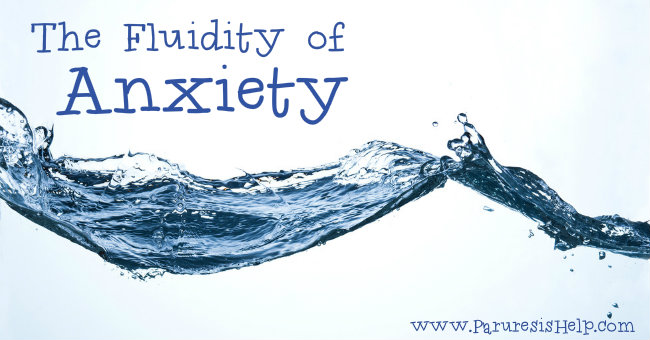
This is part three of a three-part series, “Emotional Fluidity: Learning to ‘Surf’ Anxiety.” Click here to read the rest of the series.
Mindfulness doesn’t have to be set aside like fine china, only to be used on special occasions or formal meditation sessions. You can incorporate mindfulness practices into your daily life any time you feel anxious, or any time at all.
The more you practice mindfulness, the easier and more natural it will become. Instead of a foreign concept, it can become an ingrained habit that grows strong and starts to automatically kick in every time anxiety rears its annoying little head.
Exercises: 4 Marvelous Ways to be Mindful
These marvelous mindful exercises can be effective just about anywhere: work, at the bank, on the bus, in the supermarket, or waiting in the doctor’s office. Just refrain from the exercises when you might be called on during a business meeting when you are supposed to be being mindful of your boss.
Feel free to use variations of each exercise as long as you keep the goal in mind. The main aim is to practice being acutely aware of things without judging them.
Stare at a rock.
Rocks can be pretty amazing, a fact you will find out when you stare at one for an extended period. First find a rock then take several minutes to observe the rock as if you were going to describe it to someone else. Note the color, texture, temperature, weight, size and shape. Observe every nook and cranny, every jagged edge, every smooth indentation and all other traits that can come with a rock.
You can switch up this exercise by choosing any object you like: a pen, a placemat, your shoes. Once again, the point isn’t focusing on a certain object, but focusing in general.
Tune into the noise around you.
Close your eyes and observe only sound. Taking away your eyesight heightens your other senses, and sound can be much more acute when your eyes are not trying to distract you from it. Close your eyes and simply listen to all the noise around you. Don’t judge it as annoying or soothing or good or bad, but merely take note of it with no emotions attached.
Honor your hands.
Your hands do so much throughout the day. They grasp, they clap, they fidget and they tap. Honor them by paying acute attention to their activities at various times during your busy schedule. Focusing on and honoring your hands will not only immediately draw you back to the moment, but you’ll soon be astounded at all the awesome things they do for you.
Check out the clouds.
Cloud gazing is a fabulous mindfulness exercise. Take some time to sit quietly and watch the sky, noting the different shapes, colors, and movement of the clouds across it. Unless you happen to always be near a window or skylight, literally watching the clouds flit across the sky may not be possible any time you feel anxious. You still can, however, use the concept to practice mindfulness when it comes to your thoughts.
Imagine your thoughts and emotions are like those clouds in the sky that float, stream, billow, change shapes, and otherwise move across the horizon. This concept reinforces the idea that your thoughts and emotions go through the same type of evolution and metamorphoses, never remaining the same from one moment to the next. Like the clouds, they also always pass – and always at their own pace. Just like you don’t have to hop on or try to ride a cloud, you don’t have to hop on your thoughts but observe them from distance.
Exercise: How mindfulness can help your anxiety
Informally practicing mindfulness may be great fun, but it won’t necessarily help with your anxiety unless you apply it accordingly. One of the best ways to realize how useful and important mindfulness can be for anxiety is to imagine how you can use it when you start to feel anxious at any point throughout your day.
Think of something that typically makes you feel anxious, then ask yourself how mindfulness can help. Come up with a few ideas for incorporating mindfulness into the situation.
Let’s say you’re always anxious before any presentations you have to give at work. Your thoughts tell you that you’re going to forget your notes, drop your note cards, flub up your lines and pass out in embarrassment in front of the whole company. While all these thoughts are a bunch of lies, they can also be damning when it’s your turn to get up and speak.
A helpful mindfulness technique may be deep breathing and counting to five before you get up in front of the conference room. Deep breathing immediately soothes the mind and calms the body, helping to normalize your heart rate and alleviate rapid respiration.
Another may be to focus on your hands holding the note cards and honoring them for being so strong and helping you to create the cards. Looking at your hands takes your mind off the crowd of colleagues in front of you. It also brings you back to the present moment so you can focus on delivering your presentation.
The cloud-watching technique may also be useful for quashing the anxiety that arises before a work presentation. Those nasty thoughts that tell you your presentation is going to bomb will eventually pass, just like the clouds. If you wait out the cloudy negativity, you can once again focus on the presentation at hand and deliver it under sunny skies, so to speak.
Mindfulness is more than just a technique to use in life; it can become a way of life with enough practice. Habitual mindfulness may not only help quell anxiety, but it can make each moment richer and more enjoyable. And those moments, as you’ve learned, are all we have.
This is part three of a three-part series, “Emotional Fluidity: Learning to ‘Surf’ Anxiety.” Click here to read the rest of the series.




